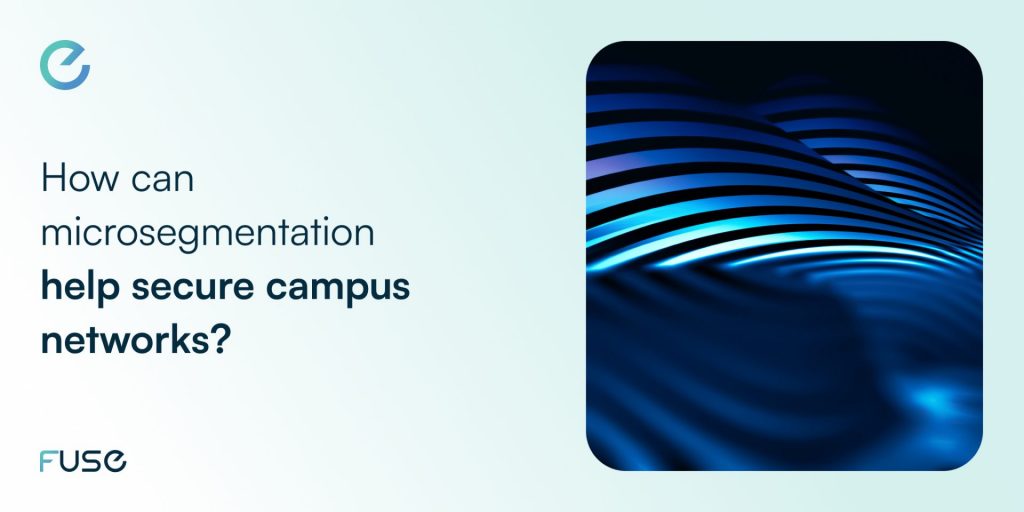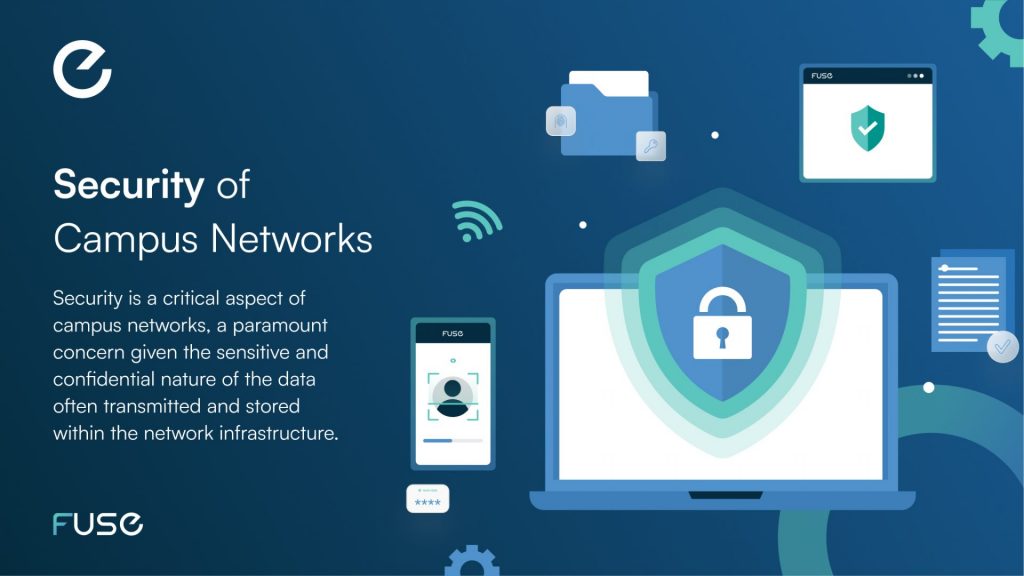How can Microsegmentation help secure campus networks?


How can Microsegmentation help secure campus networks? This blog article will explain how a campus network can benefit from implementing microsegmentation, a network security technique that breaks down networks into smaller, isolated segments, for better protection against cyber attacks.
Before we dive deep into the topic, let’s clear up what is microsegmentation, how does it work and why it is gaining more and more attention from organizations.
What is Microsegmentation?
Microsegmentation is an approach to security which involves dividing a network into smaller, isolated segments or zones. These microsegments act as separate security perimeters, isolating specific sets of resources and controlling access between them.
This approach allows organizations to install individualized security policies and controls for each microsegment, according to their specific needs.
Microsegmentation enhances security by limiting the impact of and eventual security breach. With multiple microsegments, the cyber attacks can be contained within a single segment, keeping hackers away from valuable resources and data.
What is a Campus Network?
Now that we covered what is microsegmentation, let’s switch the attention to campus networks.
Campus networks are interconnected computer networks within a specific geographical area, designed to provide reliable and secure connectivity to the various buildings and departments within the area, facilitating communication, data sharing, and resource accessibility. Examples are university campuses, corporate campuses, and any large organization
Campus Networks have many distinct features, but the most specific is the ability to handle high data traffic volumes. This is crucial since a large number of users and devices may access the network at the same time, making it essential to rely on sufficient bandwidth and scalability.
To ensure optimal functionality and accommodate the growing demand for data transmission, campus networks often utilize high-speed wired connections, such as Ethernet, fiber optic cables, or even wireless technologies like Wi-Fi.
Security of Campus Networks

Security is a critical aspect of campus networks, a paramount concern given the sensitive and confidential nature of the data often transmitted and stored within the network infrastructure.
The security of a campus network is a complex matter. To control access, campus networks employ robust mechanisms to ensure that only authorized users and devices can connect to the network. This typically involves implementing strong authentication protocols, such as usernames and passwords, two-factor authentication, or digital certificates. Network administrators can also enforce role-based access control (RBAC) to limit users’ privileges based on their roles and responsibilities within the campus.
To enhance security, they often rely on firewalls, intrusion detection, and prevention systems. Firewalls monitor and control incoming and outgoing network traffic, acting as a barrier between the internal network and external threats. Intrusion detection and prevention systems are utilized to identify and respond to any malicious activity or intrusion attempts in real time, providing an additional layer of defense against potential threats.
Apart from the methods listed above, campus networks often benefit from data encryption. To protect the confidentiality and integrity of data during transmission, campus networks often utilize encryption protocols, such as Secure Sockets Layer/Transport Layer Security (SSL/TLS) or Internet Protocol Security (IPsec). These protocols encrypt data packets, making them unreadable to unauthorized users who might attempt to intercept the information.
Prevention is important, so campus networks employ monitoring tools and security information and event management (SIEM) systems to continuously monitor network traffic, detect anomalies, and respond to security incidents promptly. This proactive approach enables the identification and mitigation of potential threats before they can cause significant damage.
Microsegmentation and Campus Networks
Although commonly associated with data center environments, microsegmentation can also be implemented in campus networks to enhance security. Here is how it works:
The campus network is divided into smaller segments or subnets. These segments can be based on factors such as department, user group, or resource type. For example, segments can be created for administration, faculty, students, research labs, or specific applications/services.
Each segment is isolated from others, meaning that traffic between segments is restricted by default. This isolation prevents the lateral movement of threats within the network. Even if an attacker gains access to one segment, their ability to move laterally and access resources in other segments is significantly limited.
Once the segments are established, security policies are applied to each segment. These policies define the rules and controls for traffic within and between segments. Policies can be based on criteria such as source IP addresses, destination IP addresses, ports, protocols, and user identity.
Microsegmentation allows for granular access control, enabling administrators to define precise permissions for different user groups or resources.
For example, a segment containing sensitive data may have stricter access controls than a segment used for general-purpose services. This level of control helps minimize the attack surface and restricts access to critical assets.
Microsegmentation – An effective tool for Campus Networks
To enable communication between segments when necessary, segmentation gateways or devices are deployed. These gateways enforce security policies and act as intermediaries for traffic between segments. They inspect and control the traffic to ensure that it adheres to the defined security policies.
And the last step… monitoring and managing the implemented protocol. Microsegmentation typically involves robust monitoring and management capabilities. This allows administrators to gain visibility into traffic patterns, detect anomalies, and manage security policies effectively. Centralized management platforms and security tools are often used to streamline the configuration and monitoring processes.
By implementing microsegmentation in a campus network, organizations can achieve enhanced security by containing potential security breaches and limiting the impact of any compromised segments. It provides a more fine-grained and context-aware security approach compared to traditional perimeter-based security controls, helping organizations defend against lateral movement of threats and reducing the potential for data exfiltration or unauthorized access to critical resources within the campus networks.
Fuse helps with Microsegmentation
If you’re considering implementing microsegmentation in your organization or campus network but don’t know where to start, our digital enablement platform, eTag Fuse, can help.
Fuse simplifies microsegmentation for you. One of its key features is that it provides granular access controls, which are essential for micro-segmentation. The platform allows organizations to define policies that limit access to specific resources based on factors such as user identity, location, and time of day.
This level of granularity helps organizations ensure that only authorized users have access to sensitive resources, which can significantly reduce the risk of data breaches.
Fuse also offers a comprehensive set of identity management capabilities. This includes user provisioning, deprovisioning, and access management, as well as support for multi-factor authentication (MFA) and single sign-on (SSO). These features help organizations streamline their Identity and Access Management (IAM) processes and reduce the burden on IT teams.
In conclusion
The eTag Fuse platform solves the scalability problem, being suitable for organizations of all sizes. The platform can easily accommodate thousands of users and devices, making it ideal for large enterprises. Additionally, the platform is designed to integrate with existing security infrastructure, such as firewalls and intrusion detection systems, which helps organizations improve their overall security posture.
In addition, the eTag Fuse platform offers advanced analytics and reporting capabilities. This allows organizations to gain insights into user behavior and identify potential security risks. The platform generates detailed reports that highlight trends and anomalies, allowing organizations to proactively address security issues before they become a problem.
Finally, the eTag Fuse platform is a powerful solution that offers advanced IAM and identity management capabilities in the context of micro-segmentation. Its granular access controls, comprehensive identity management features, scalability, and analytics capabilities make it an ideal solution for organizations looking to improve their security posture and streamline their IAM processes.
Contact us today to learn more about how eTag Fuse can help your organization!

Sources:
- https://www.cloudflare.com/learning/network-layer/what-is-a-campus-area-network/
- https://www.paloaltonetworks.com/cyberpedia/what-is-microsegmentation
- https://www.vationventures.com/session-summaries/micro-segmentation-on-an-open-campus-network
- https://www.akamai.com/glossary/what-is-microsegmentation

















